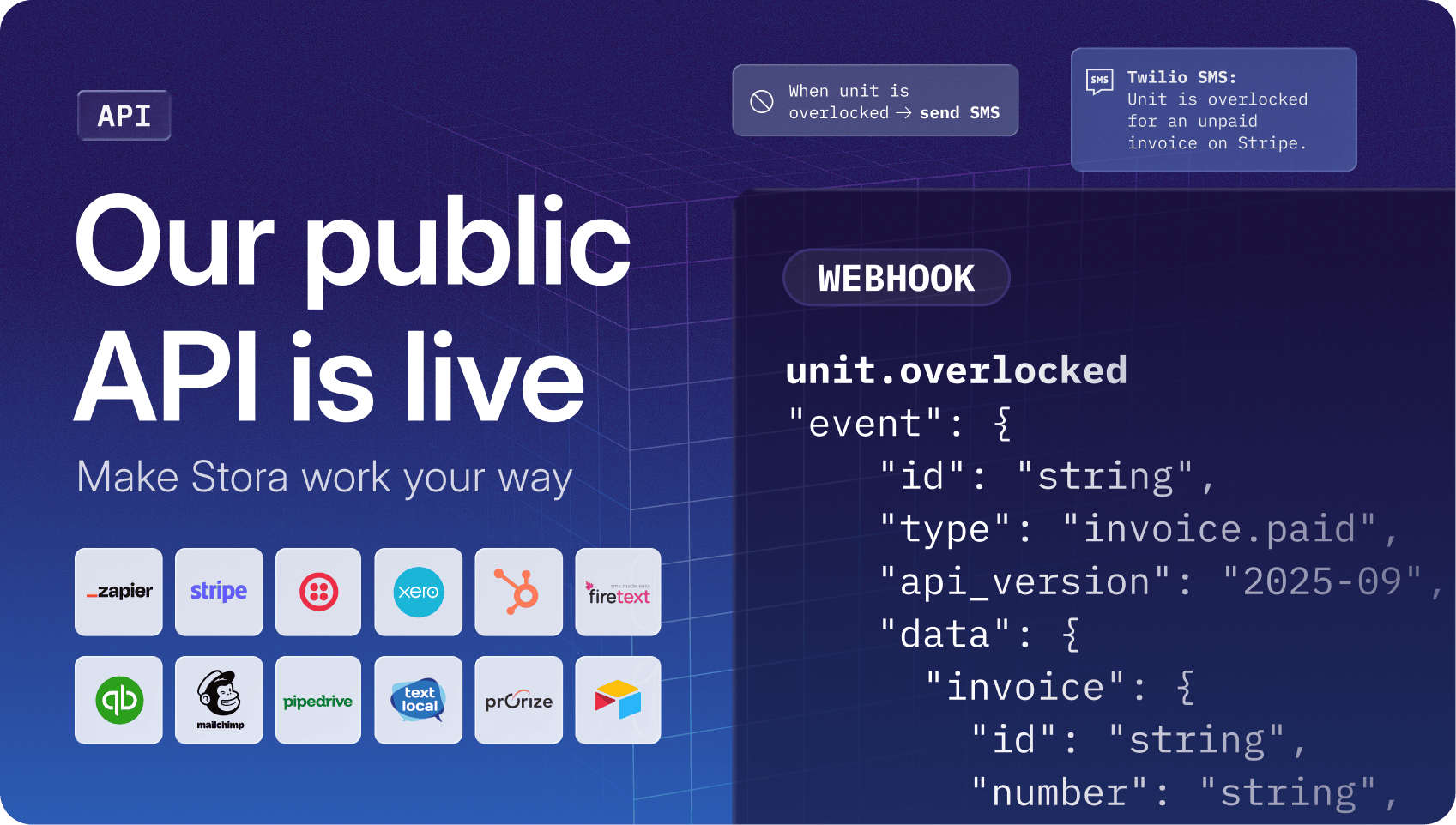In January 2019, I sold some shares in one of my startups and decided to use the money to set up a storage business. This is the story of how I built an automated self storage business that requires fewer than 2 hours per week of my time and is on track to generate £8k per month by the end of 2021.
It was early 2019. Ten years of launching tech products, with various levels of success and failure, had left me jaded. Building technology and seeing it used by thousands of people was fun, but turning that into a business (with meaningful revenues and profits) was proving very difficult.
I had just sold some shares and decided to invest the proceeds into something totally different: self storage. With global demand growth, a UK market one-tenth the size of the more mature US market, and recurring revenues, it seemed like a solid option. And, when I saw limited use of modern technology at many existing facilities and on their websites, I sensed a big opportunity.

But, before I could get started, there were some big decisions to be made:
Shipping container vs purpose-built indoor facility
In the end, this decision was easy. The low initial set up costs of a shipping container business (you can simply buy containers as demand grows) seemed attractive at first glance. But this meant that anyone could compete with me in the future. In other words, the barriers to entry were really low. On the other hand, an indoor facility with a professional fit-out had much higher upfront costs. Since this would make it harder for anyone looking to compete, and given the benefits of indoor storage (dry, ventilated, safer, much greater flexibility on room sizes), I opted for an indoor facility.
While there is a place for outdoor shipping container businesses, I believe the future of self storage belongs to purpose-built, indoor facilities.

Rent or buy a warehouse
While I would have preferred to have bought a warehouse, I didn’t have enough funds. So, I had to rent. To make sure I got a decent return on my investment, I took a 20 year lease. I also spent around £4k on legal fees to make sure there was no chance of getting booted out against my will.
Location
Getting the balance right between visibility, price, demographics, and competition is key. While cities like Belfast—and all big UK cities—have huge self storage facilities, towns with populations of 10-50k people tended to have no indoor warehouse-based self storage. The traditional warehouse-based operators usually have staff, reception, and a shop selling packing materials. To make that work financially, they need to build huge facilities with hundreds or thousands of units.
The opportunity I saw was to apply technology and automation to make smaller, town-based facilities economically viable.
I started by mapping every single self storage facility in Northern Ireland, and identified towns with no existing facility within three miles. I found census data and ruled out any town with fewer than 15k inhabitants. I also wanted somewhere within 30 minutes drive of where I lived. This left me with a list of four possible locations, and in the end I found a great spot in a town called Portadown. It was highly visible, along a busy road, and about 500 metres from the town centre. I agreed terms with the landlord in May, signed the contract in June, and got the keys in September (just as my fit out arrived on site).

Automation
I decided to design the business to be as automated as possible. This would keep costs down, prices low, and allow me to focus on opening new facilities or on other businesses.
I decided to build a website for customers to book directly. Technology would allow customers to move in and out themselves (no check-in and no reception). I didn’t want any on-site employees. Payments and accounts would also be automated.
When it came to the fit-out, my desire for automation meant going with Janus and their Nokē solution for doors. Nokē allows all doors and units to be opened using a mobile app.
Showing prices online and allowing direct bookings
A lot of self storage providers don’t show prices online, let alone allow online booking. It took me a while to work out why. In some cases it’s down to limited technical expertise. But from what I understand, in many cases it is so that different pricing can be offered to different customers. Typically, this means raising prices on long-term customers to drive margin growth. While I understand this benefit, and my system could allow this in the future, the increasing importance of transparency to younger, tech-savvy consumers meant I decided to publish prices and allow direct bookings online.

Other considerations
I decided to register for VAT from the start. This allowed me to reclaim around £20k on the initial fit out costs, which was key for cashflow. The downside of having to charge VAT to non-business customers was a pain, but I would likely pass the threshold within two years anyway, so the cashflow benefit to claiming VAT now on fit out costs outweighed that. Other minor decisions were around name (StoreStuff won in the end), who to use for emails (Google), documents (G Drive), and whether to sell boxes or not (maybe online, but certainly not at the facility—as that would probably require full time staff).
With all those decisions made, it was time to make everything happen. It was May 2019 and I wanted to open by the end of the summer. So, what next?
I needed to build the self storage software, hardware, and services I’d need to run the business. Below is a map of everything we used and how it all connected together. You can download the pdf here.

The booking and room management system (the left hand side of the map) was the most complex part of the puzzle to solve. I broke it down into three individual problems, each one involved bringing together a variety of hardware and software products.
1. Booking system
There are three ways customers reach out to make a booking.
- Website - built using Middleman, hosted on Netlify and deployed via GitHub, where the code is stored. Netlify provides a free CMS—a content management system that allows quick and easy updating of site content—for website frameworks like Middleman. I use the free version of Hubspot to provide live online chat and their meeting organiser to let people arrange a time to view the facility (I get a notification telling me when to be on site to meet them).
- Telephone - I use TTNC to provide a local telephone number that comes through to my mobile phone. My guess is there are better services out there for less money, but this works fine for me for now.
- Walk Ins - lots of people still turn up at the facility and expect there to be someone on site to show them around. Making the experience match expectations for these people is one of the biggest challenges for unmanned facilities. I installed a Nest Hello doorbell at the front which, when pressed, calls my mobile phone. That allows me to speak directly to the visitor then either arrange a time to meet or give them a remote tour of the facility using Nokē to open doors for them. To be frank, this is still not ideal and I’m working on ways to improve this experience. If you have come up against the same problem, please get in touch and let me know how you got on.
Once people had decided to book, I wanted them to self serve using a booking system that would:
- allow customers to book online themselves; and
- handle automated recurring payments
In the end, I opted to go with ChargeBee, a recurring payment system with dozens of other useful features (including invoicing, a booking portal for customers, and a self service customer management portal), using Stripe as the payment provider in the background. I considered implementing Direct Debits using GoCardless and connecting that up to ChargeBee, too, but in the end decided to allow card payments only. Card payment success or failure comes through instantly, meaning I could more easily stay on top of missed payments if they happened.
Six months in, and nobody has ever raised an issue about only accepting card payments. I’ve had one missed payment, which was picked up and corrected the same day. Everyone pays monthly in advance which is obviously superb for cashflow.

2. Room entry/management
I opted for the Nokē system on the doors because this allows customers to let themselves in and out of the facility without staff being there.
Alongside that is the Nokē mobile app, which allows customers (and managers) to enter the facility and units. Managers cannot access units that are in use. One of the coolest features of the app is that customers can share their access with family, friends, or colleagues.
3. Connecting bookings and room entry/management together
Getting the booking system and room entry system to talk to each other was the final piece of this puzzle. In other words, once a customer booked and paid online, I had to find a way for the Nokē system to know to give them access to a specific room on a specific date.
There was an existing solution: Property Management Systems. I reviewed two and found some seriously annoying limitations: one only worked on Windows machines (huh?), one needed me to log into it to run payments (had they heard of running tasks automatically in the background?!), and one particularly annoying feature was that to send a customer an email, I had to first write it on Microsoft Word then upload it to the system.
I felt like I’d travelled back in time and landed in 1998.
So this is the part I decided to build myself, with the help of some friends. We built the StoreStuff Room Management System, a lightweight software product that I use to add new tenants and give them access to, and remove access to, their units. It communicates with Nokē via their API. It is a very lightweight piece of tech, but gives me the freedom to communicate with the Nokē system without some expensive and clunky piece of software sitting in the way. Customers can move in themselves and come and go as they please.(Update: this personal system has since evolved into Stora self storage software), a commercial solution for self storage operators.).
If you are considering using Nokē, get in touch as I’d be happy to share more information about my experience.
Others
Those three parts of the puzzle really were the most challenging to work out and piece together. Beyond that, everything else has been relatively straightforward.
I use Xero for my accounts. I use Tide for my banking (since they are online only, I knew I’d never be required to go to a branch to do anything). My Stripe payments—my revenue—land into my Tide account on a weekly basis and are then automatically posted to Xero as revenue. This makes accounting really simple. All my expenses are put onto my Tide debit card, so they also appear in Xero automatically. I do my accounts once every quarter in line with VAT timings and it takes about an hour.
The Nokē mobile app tells me—by notification on my mobile phone (don’t worry you can turn them off!)—when someone is on site. Cameras installed by Janus and connected to HiK Connect mobile app let me watch anyone on site.
My marketing and PR can’t be automated or outsourced yet, sadly, and I mostly use paid Google ads as well as Facebook ads (advertising only to people within a 10 mile radius of my facility). Our SEO is doing well for now—number 1 in the local area—so I don’t rely on Google ads too much yet. I create the odd promo video (see below) using iMovie on my iPhone and typically upload them to YouTube.
Other than that, other services I’ve used are Basil Fry for insurance, Namecheap for domain purchases and management, and G Suite for emails and documents.
So far, so good. The business opened on 18th September 2019 and within six months we had over £3k of monthly recurring revenue, and we are on track (coronavirus dependent of course!) to hit £8k of profit per month by the end of 2021. I made an initial investment of just short of £100k, which covered Phase 1 of the fit-out (49 rooms), website and technology development, signage, and other bits and pieces, as well as a concert to celebrate the opening!
The next phase of the fit-out (43 more rooms) will cost an additional £45k, and by the time I get to 135 units, I will have invested around £190k in total. So far the coronavirus hasn’t affected us too badly, but only time will tell how that goes in the long term.
I run a self storage business. How can this help me?
If you want to reduce costs, streamline your business, and be better positioned for success in the turbulent times ahead, I would strongly suggest taking a look at the various software and hardware services I have covered here. Compared to the off-the-shelf self storage solutions, they give you much more control and flexibility over the way you run your business and will help you to compete and win in future.
Of course your business can still run successfully on other systems, but as the industry grows and matures, self storage providers who adopt modern technologies to drive efficiencies in their business will win.
Do I need to use Nokē’s door solution for the rest of this to work?
Absolutely not. Doors, using Nokē, are just one element of the business that is automated. Lots of other stuff, like bookings and payments, can be automated without Nokē.
The same applies to payments or your booking system—if you already have something that works in a specific area, you can usually leave it in place while still making improvements in other areas.
If you have any comments or questions about any of this, or for a chat about self storage, get in touch anytime. Thanks for reading!
Gavin Shields is the CEO at Stora, a provider of automated self storage software and services, as well as the MD & Owner of StoreStuff, a self storage operator based in Northern Ireland. Previously, Gavin was CEO at leading UK fintech, Yomo/PiggyPot, co-founder and COO at games tech provider Turbulenz, and an investor at $15bn VC and private equity firm, Summit Partners. Gavin consults to self storage operators, particularly in relation to automation. You can contact Gavin at gavin@stora.co.
Recommended reading
How to become a self storage millionaire
Is self storage investing a good idea
FREE self storage financial model
UK self storage ecosystem - everything you need to run a self storage business
Optimise your self storage website to attract customers through organic search results
Manned or unmanned site - Automation benefits everyone!
Self storage growth guide
Check out the ultimate guide to growing your self storage business.








